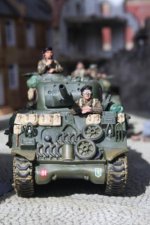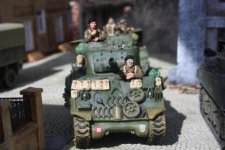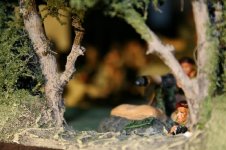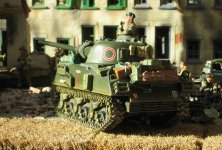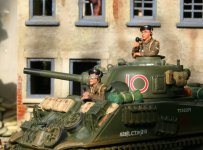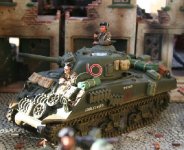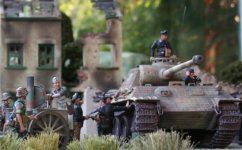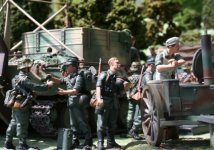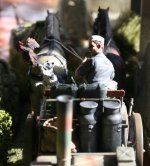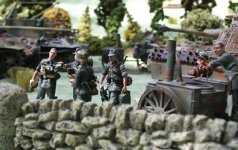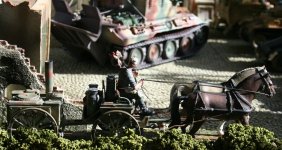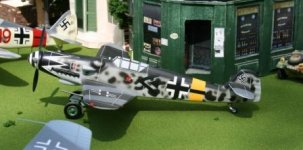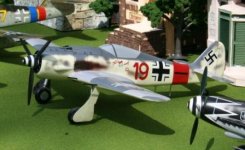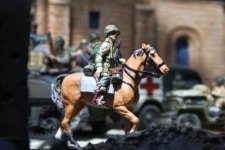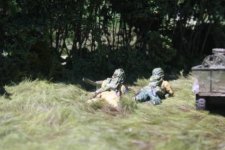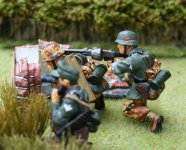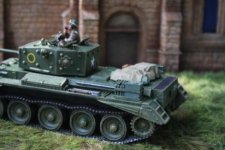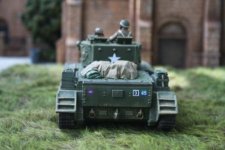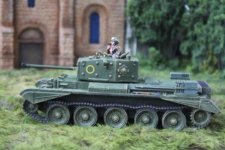panda1gen
Colonel
- Joined
- Jul 29, 2005
- Messages
- 8,154
[FONT="]At launch the A-4 propelled itself for up to 65 seconds on its own power, and a program motor controlled the pitch to the specified angle at engine shutdown, from which the rocket continued on a free-fall ([/FONT][FONT="]ballistic[/FONT][FONT="]) trajectory. The rocket reached a height of 80 km (50 mi) after shutting off the engine.[/FONT][FONT="][21][/FONT]
[FONT="]
The V-2 was guided by four external rudders on the tail fins, and four internal [/FONT][FONT="]graphite[/FONT][FONT="]vanes[/FONT][FONT="] at the exit of the motor. The LEV-3 guidance system consisted of two free [/FONT][FONT="]gyroscopes[/FONT][FONT="] (a horizon and a vertical) for lateral stabilization, and a [/FONT][FONT="]PIGA accelerometer[/FONT][FONT="] to control engine cutoff at a specified velocity. Some later V-2s used "guide beams" (radio signals transmitted from the ground) to navigate towards the target, but the first models used a simple [/FONT][FONT="]analog computer[/FONT][FONT="] that adjusted the [/FONT][FONT="]azimuth[/FONT][FONT="] for the rocket, and the flying distance was controlled by the timing of the engine cut-off, "Brennschluss", ground controlled by a Doppler system or by different types of on-board integrating accelerometers. The rocket stopped accelerating and soon reached the top of the (approximately [/FONT][FONT="]parabolic[/FONT][FONT="]) flight curve.[/FONT]
[FONT="]
The painting of the operational V-2s was mostly a [/FONT][FONT="]camouflage[/FONT][FONT="] ragged pattern with several variations, but at the end of the war a plain olive green rocket also appeared. During tests, the rocket was painted in a characteristic black-and-white [/FONT][FONT="]chessboard[/FONT][FONT="] pattern, which aided in determining if the rocket was spinning around its longitudinal axis.[/FONT]
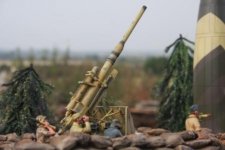
This Figarti 88mm is guarding a V2 site with A4 rocket in camo alonside.
http://en.wikipedia.org/wiki/Meillerwagen
The Meillerwagen (English: Meiller Vehicle) was a German World War II trailer used to transport a V-2 rocket from the 'transloading point'[1]1 of the Technical Troop Area to the 'launching point', to erect the missile on the Brennstand (English: firing stand),2 and to act as the service gantry for fuelling and launch preparation. The unofficial 'Meillerwagen'3 name was often used in official documents and refers to a parts supplier for the trailer, Meiller-Kipper GmbH of Munich, Germany (founded 1850).
The Army Research Center Peenemünde designed the Meillerwagen, and the Gollnow & Son company assembled the Meillerwagen from supplied components. The Meillerwagen was assembled with ItalianRussian prisoner laborers of the Lager Rebstock. The Meillerwagen was vehicle code number 102 of several vehicles in a V-2 launching battery,[2] which included an 8 ton launch control vehicle. Launching of V-2s from mobile equipment was studied under code name Regenwurm ("Earthworm") to replace bunkers such as at Le Blockhaus.[3]
Following Operation Crossbow bombing, initial plans for launching from the massive underground Le Blockhaus and La Coupole or from fixed pads such as near the Chateau du Molay[26] were dropped in favor of mobile launching. Eight main storage dumps were planned and four had been completed by July 1944 (the one at Mery-sur-Oise[27] The missile could be launched practically anywhere, roads running through forests being a particular favorite. The system was so mobile and small that not one Meillerwagen was caught in action by Allied aircraft,[citation needed] although Raymond Baxter reported that he shot at a V2 from his Spitfire as it was launched.
An average of ten V-2s could be launched per day and up to 1000 V-2s could be launched per month, given sufficient supply of the rockets.[28]
Rocket near bunker, in camo pattern
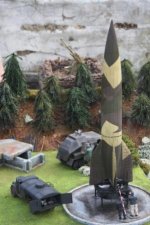
Rocket in test colours
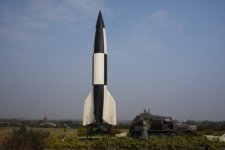
Troops involved in launch, all Figarti
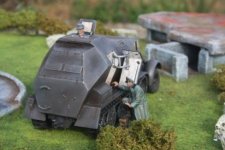
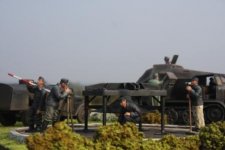
View attachment 43655
[FONT="]
The V-2 was guided by four external rudders on the tail fins, and four internal [/FONT][FONT="]graphite[/FONT][FONT="]vanes[/FONT][FONT="] at the exit of the motor. The LEV-3 guidance system consisted of two free [/FONT][FONT="]gyroscopes[/FONT][FONT="] (a horizon and a vertical) for lateral stabilization, and a [/FONT][FONT="]PIGA accelerometer[/FONT][FONT="] to control engine cutoff at a specified velocity. Some later V-2s used "guide beams" (radio signals transmitted from the ground) to navigate towards the target, but the first models used a simple [/FONT][FONT="]analog computer[/FONT][FONT="] that adjusted the [/FONT][FONT="]azimuth[/FONT][FONT="] for the rocket, and the flying distance was controlled by the timing of the engine cut-off, "Brennschluss", ground controlled by a Doppler system or by different types of on-board integrating accelerometers. The rocket stopped accelerating and soon reached the top of the (approximately [/FONT][FONT="]parabolic[/FONT][FONT="]) flight curve.[/FONT]
[FONT="]
The painting of the operational V-2s was mostly a [/FONT][FONT="]camouflage[/FONT][FONT="] ragged pattern with several variations, but at the end of the war a plain olive green rocket also appeared. During tests, the rocket was painted in a characteristic black-and-white [/FONT][FONT="]chessboard[/FONT][FONT="] pattern, which aided in determining if the rocket was spinning around its longitudinal axis.[/FONT]

This Figarti 88mm is guarding a V2 site with A4 rocket in camo alonside.
http://en.wikipedia.org/wiki/Meillerwagen
The Meillerwagen (English: Meiller Vehicle) was a German World War II trailer used to transport a V-2 rocket from the 'transloading point'[1]1 of the Technical Troop Area to the 'launching point', to erect the missile on the Brennstand (English: firing stand),2 and to act as the service gantry for fuelling and launch preparation. The unofficial 'Meillerwagen'3 name was often used in official documents and refers to a parts supplier for the trailer, Meiller-Kipper GmbH of Munich, Germany (founded 1850).
The Army Research Center Peenemünde designed the Meillerwagen, and the Gollnow & Son company assembled the Meillerwagen from supplied components. The Meillerwagen was assembled with ItalianRussian prisoner laborers of the Lager Rebstock. The Meillerwagen was vehicle code number 102 of several vehicles in a V-2 launching battery,[2] which included an 8 ton launch control vehicle. Launching of V-2s from mobile equipment was studied under code name Regenwurm ("Earthworm") to replace bunkers such as at Le Blockhaus.[3]
Following Operation Crossbow bombing, initial plans for launching from the massive underground Le Blockhaus and La Coupole or from fixed pads such as near the Chateau du Molay[26] were dropped in favor of mobile launching. Eight main storage dumps were planned and four had been completed by July 1944 (the one at Mery-sur-Oise[27] The missile could be launched practically anywhere, roads running through forests being a particular favorite. The system was so mobile and small that not one Meillerwagen was caught in action by Allied aircraft,[citation needed] although Raymond Baxter reported that he shot at a V2 from his Spitfire as it was launched.
An average of ten V-2s could be launched per day and up to 1000 V-2s could be launched per month, given sufficient supply of the rockets.[28]
Rocket near bunker, in camo pattern

Rocket in test colours

Troops involved in launch, all Figarti


View attachment 43655



